Abstract
The primary structure of two highly crossreactive human histocompatibility antigens, HLA-A28 and HLA-A2, has been determined to 96% and 90%, respectively, of the papain-solubilized molecules. Their sequences have been compared with the sequence of HLA-B7 and with each other in order to outline the sites of diversity. The overall homology between HLA-B7 and these HLA-A antigens is 86%. A large majority of the differences are located between residues 43 and 195. Within this area, substitutions cluster in at least three segments--residues 65-80, 105-116, and 177-194. HLA-A28 and HLA-A2 show 96% homology. Most of the differences fall within segments 65-74 and 107-116. These results strongly support the suggestion that residues in these segments are integral parts of the alloantigenic determinants of HLA-A28 and HLA-A2. It is further proposed that these three clusters may constitute major, albeit not exclusive, sites of antigenic diversity in human histocompatibility antigens. The nature of the differences among HLA-B7, HLA-A28, and HLA-A2 in the first variable segment suggests that gene conversion might play some role in the generation of HLA polymorphism.
Full text
PDF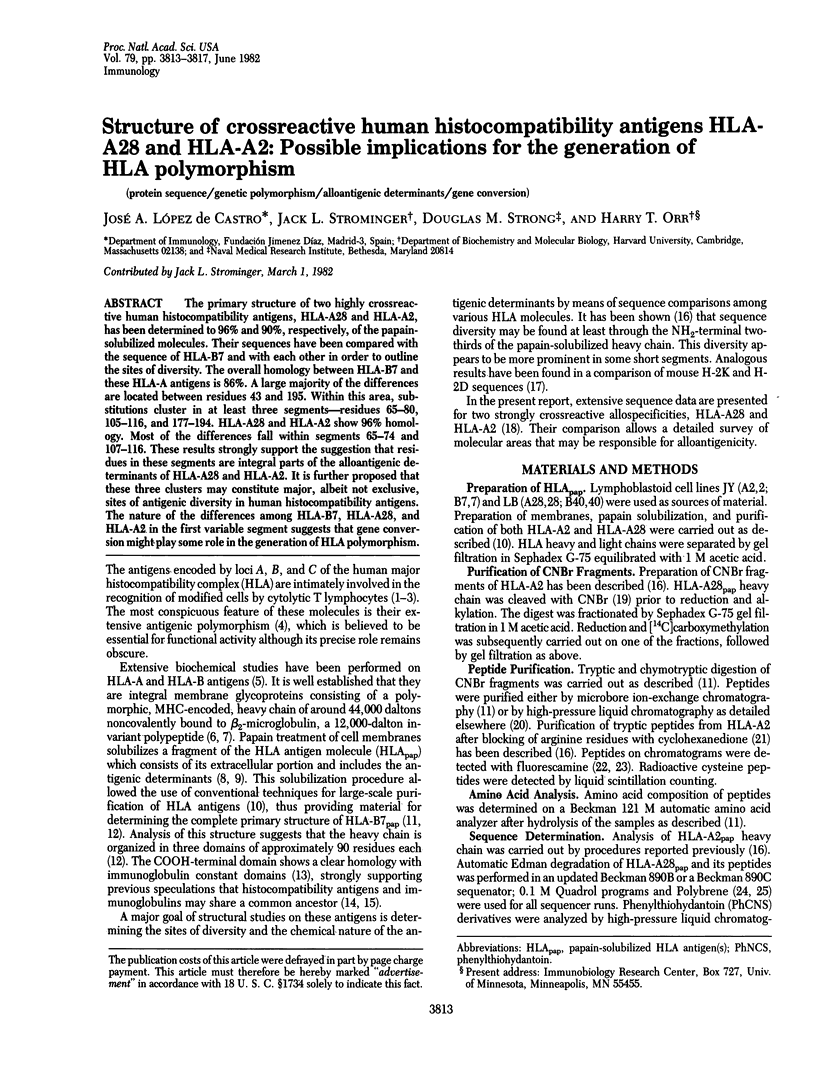
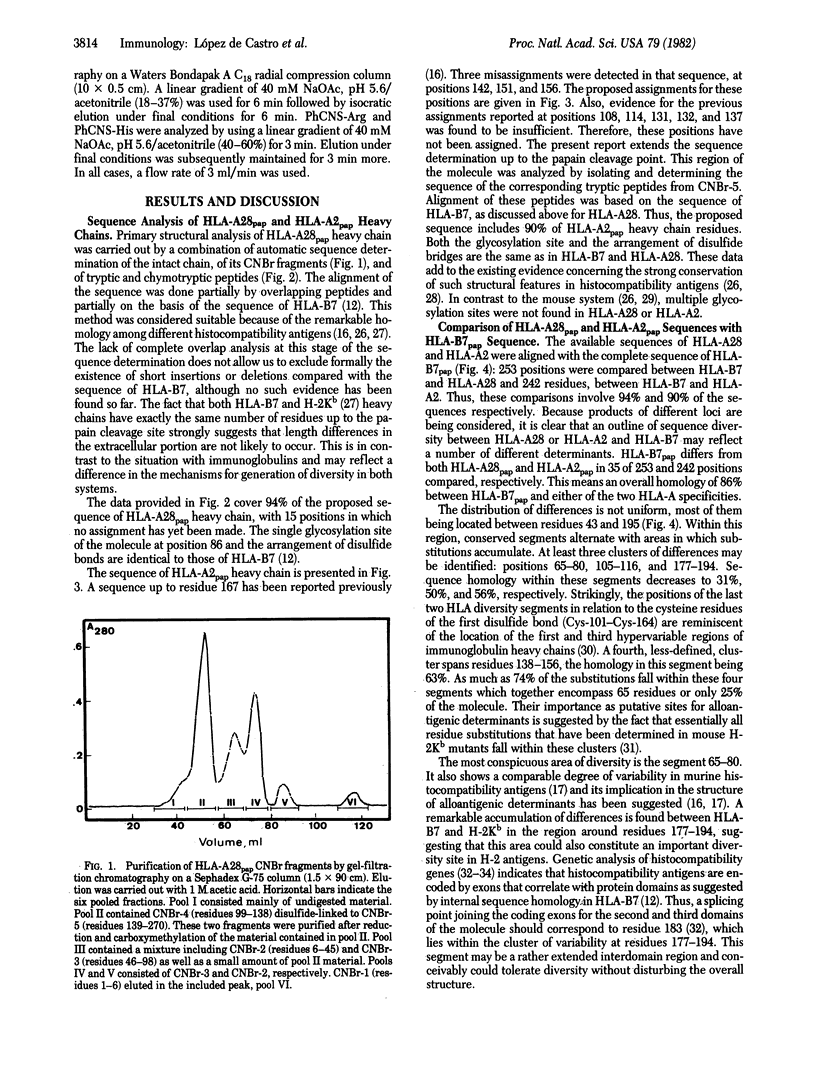
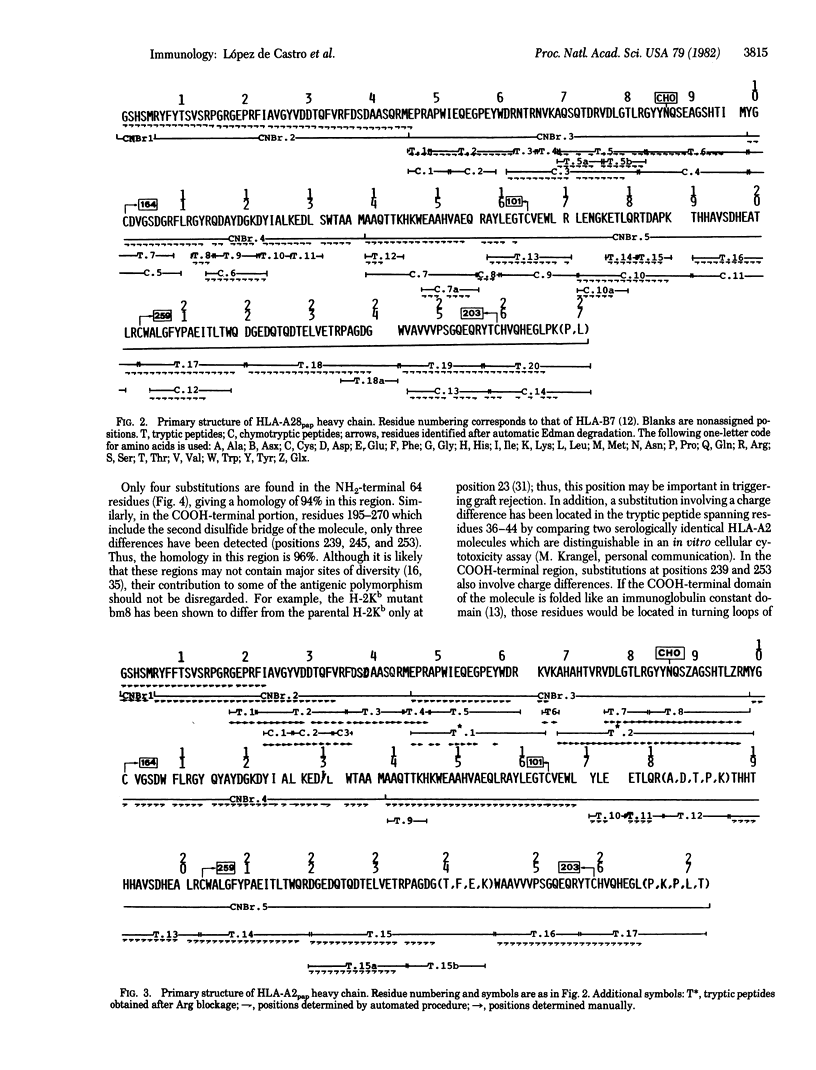
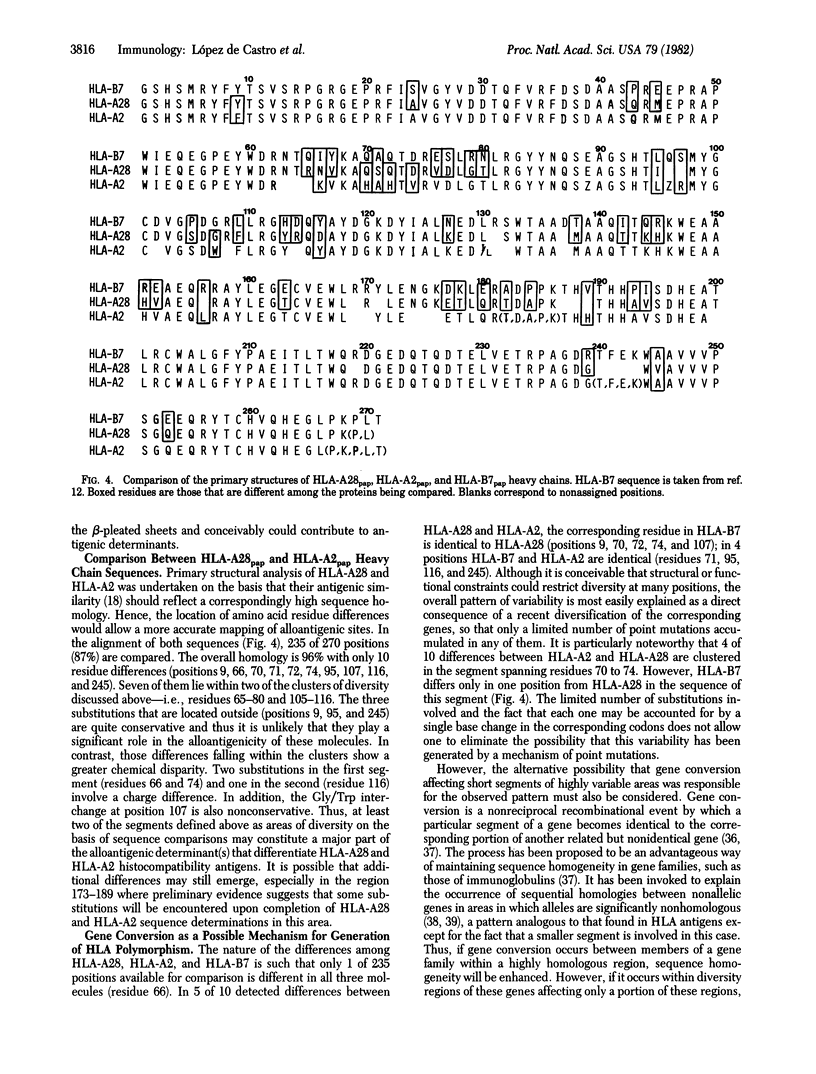
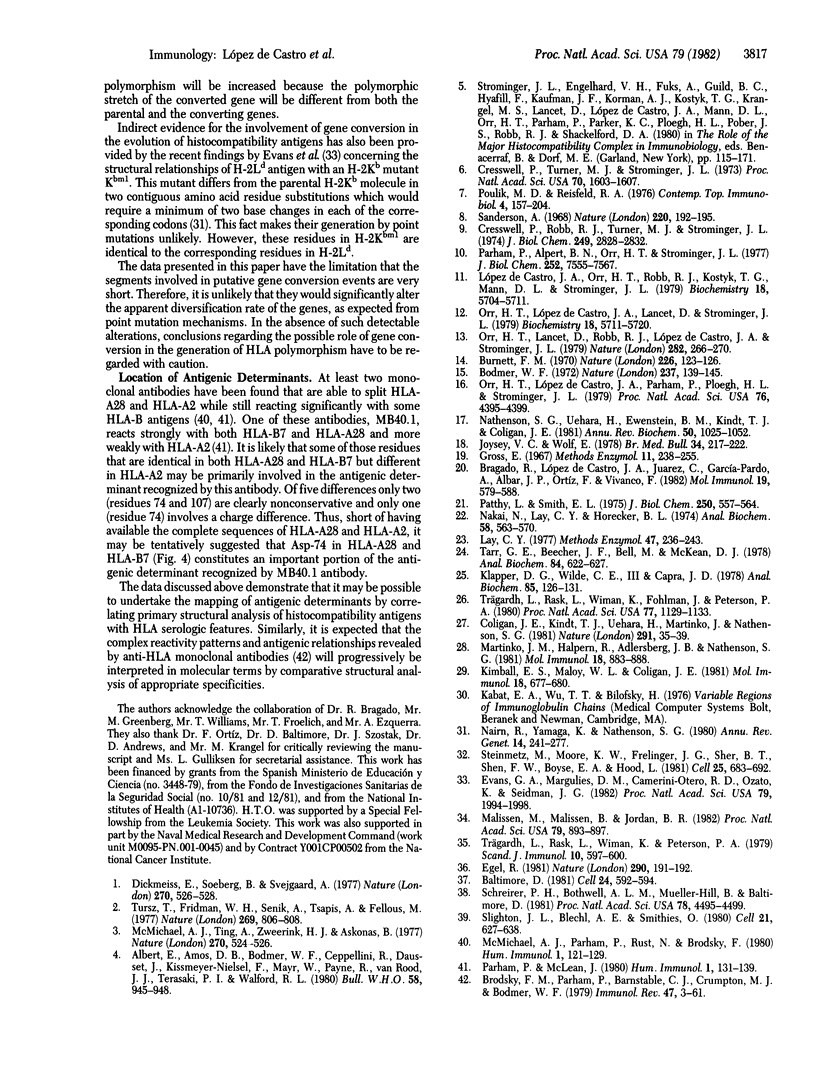
Selected References
These references are in PubMed. This may not be the complete list of references from this article.
- Baltimore D. Gene conversion: some implications for immunoglobulin genes. Cell. 1981 Jun;24(3):592–594. doi: 10.1016/0092-8674(81)90082-9. [DOI] [PubMed] [Google Scholar]
- Bodmer W. F. Evolutionary significance of the HL-A system. Nature. 1972 May 19;237(5351):139–passim. doi: 10.1038/237139a0. [DOI] [PubMed] [Google Scholar]
- Bragado R., López de Castro J. A., Juárez C., Albar J. P., García Pardo A., Ortí F., Vivanco-Martínez F. Chemical modification of carboxyl groups in human Fcgamma fragment --II. Location of acidic residues involved in complement activation. Mol Immunol. 1982 Apr;19(4):579–588. doi: 10.1016/0161-5890(82)90227-9. [DOI] [PubMed] [Google Scholar]
- Brodsky F. M., Parham P., Barnstable C. J., Crumpton M. J., Bodmer W. F. Monoclonal antibodies for analysis of the HLA system. Immunol Rev. 1979;47:3–61. doi: 10.1111/j.1600-065x.1979.tb00288.x. [DOI] [PubMed] [Google Scholar]
- Burnet F. M. A certain symmetry: histocompatibility antigens compared with immunocyte receptors. Nature. 1970 Apr 11;226(5241):123–126. doi: 10.1038/226123a0. [DOI] [PubMed] [Google Scholar]
- Coligan J. E., Kindt T. J., Uehara H., Martinko J., Nathenson S. G. Primary structure of a murine transplantation antigen. Nature. 1981 May 7;291(5810):35–39. doi: 10.1038/291035a0. [DOI] [PubMed] [Google Scholar]
- Cresswell P., Robb R. J., Turner M. J., Strominger J. L. Papain-solubilized HL-A antigens. Chromatographic and electrophoretic studies of the two subunits from different specificities. J Biol Chem. 1974 May 10;249(9):2828–2832. [PubMed] [Google Scholar]
- Cresswell P., Turner M. J., Strominger J. L. Papain-solubilized HL-A antigens from cultured human lymphocytes contain two peptide fragments. Proc Natl Acad Sci U S A. 1973 May;70(5):1603–1607. doi: 10.1073/pnas.70.5.1603. [DOI] [PMC free article] [PubMed] [Google Scholar]
- Dickmeiss E., Soeberg B., Svejgaard A. Human cell-mediated cytotoxicity against modified target cells is restricted by HLA. Nature. 1977 Dec 8;270(5637):526–528. doi: 10.1038/270526a0. [DOI] [PubMed] [Google Scholar]
- Egel R. Intergenic conversion and reiterated genes. Nature. 1981 Mar 19;290(5803):191–192. doi: 10.1038/290191a0. [DOI] [PubMed] [Google Scholar]
- Evans G. A., Margulies D. H., Camerini-Otero R. D., Ozato K., Seidman J. G. Structure and expression of a mouse major histocompatibility antigen gene, H-2Ld. Proc Natl Acad Sci U S A. 1982 Mar;79(6):1994–1998. doi: 10.1073/pnas.79.6.1994. [DOI] [PMC free article] [PubMed] [Google Scholar]
- Joysey V. C., Wolf E. HLA-A, -B and -C antigens, their serology and cross-reaction. Br Med Bull. 1978 Sep;34(3):217–222. doi: 10.1093/oxfordjournals.bmb.a071501. [DOI] [PubMed] [Google Scholar]
- Kimball E. S., Maloy W. L., Coligan J. E. Evidence for three carbohydrate prosthetic groups on mouse histocompatibility antigens H-2Kd and H-2Db. Mol Immunol. 1981 Jul;18(7):677–680. doi: 10.1016/0161-5890(81)90039-0. [DOI] [PubMed] [Google Scholar]
- Klapper D. G., Wilde C. E., 3rd, Capra J. D. Automated amino acid sequence of small peptides utilizing Polybrene. Anal Biochem. 1978 Mar;85(1):126–131. doi: 10.1016/0003-2697(78)90282-8. [DOI] [PubMed] [Google Scholar]
- Lai C. Y. Detection of peptides by fluorescence methods. Methods Enzymol. 1977;47:236–243. doi: 10.1016/0076-6879(77)47028-9. [DOI] [PubMed] [Google Scholar]
- López de Castro J. A., Orr H. T., Robb R. J., Kostyk T. G., Mann D. L., Strominger J. L. Complete amino acid sequence of a papain-solubilized human histocompatibility antigen HLA-B7. 1. Isolation and amino acid composition of fragments and of tryptic and chymotryptic peptides. Biochemistry. 1979 Dec 11;18(25):5704–5711. doi: 10.1021/bi00592a029. [DOI] [PubMed] [Google Scholar]
- Malissen M., Malissen B., Jordan B. R. Exon/intron organization and complete nucleotide sequence of an HLA gene. Proc Natl Acad Sci U S A. 1982 Feb;79(3):893–897. doi: 10.1073/pnas.79.3.893. [DOI] [PMC free article] [PubMed] [Google Scholar]
- Martinko J. M., Halpern R., Adlersberg J. B., Nathenson S. G. Structure of murine major histocompatibility complex alloantigens: identification of cysteine residues involved in two intrachain disulfide bonds of H-2K. Mol Immunol. 1981 Oct;18(10):883–888. doi: 10.1016/0161-5890(81)90011-0. [DOI] [PubMed] [Google Scholar]
- McMichael A. J., Parham P., Rust N., Brodsky F. A monoclonal antibody that recognizes an antigenic determinant shared by HLA A2 and B17. Hum Immunol. 1980 Sep;1(2):121–129. doi: 10.1016/0198-8859(80)90099-3. [DOI] [PubMed] [Google Scholar]
- McMichael A. J., Ting A., Zweerink H. J., Askonas B. A. HLA restriction of cell-mediated lysis of influenza virus-infected human cells. Nature. 1977 Dec 8;270(5637):524–526. doi: 10.1038/270524a0. [DOI] [PubMed] [Google Scholar]
- Nairn R., Yamaga K., Nathenson S. G. Biochemistry of the gene products from murine MHC mutants. Annu Rev Genet. 1980;14:241–277. doi: 10.1146/annurev.ge.14.120180.001325. [DOI] [PubMed] [Google Scholar]
- Nakai N., Lai C. Y., Horecker B. L. Use of fluorescamine in the chromatographic analysis of peptides from proteins. Anal Biochem. 1974 Apr;58(2):563–570. doi: 10.1016/0003-2697(74)90225-5. [DOI] [PubMed] [Google Scholar]
- Nathenson S. G., Uehara H., Ewenstein B. M., Kindt T. J., Coligan J. E. Primary structural: analysis of the transplantation antigens of the murine H-2 major histocompatibility complex. Annu Rev Biochem. 1981;50:1025–1052. doi: 10.1146/annurev.bi.50.070181.005113. [DOI] [PubMed] [Google Scholar]
- Orr H. T., Lancet D., Robb R. J., Lopez de Castro J. A., Strominger J. L. The heavy chain of human histocompatibility antigen HLA-B7 contains an immunoglobulin-like region. Nature. 1979 Nov 15;282(5736):266–270. doi: 10.1038/282266a0. [DOI] [PubMed] [Google Scholar]
- Orr H. T., Lopez de Castro J. A., Parham P., Ploegh H. L., Strominger J. L. Comparison of amino acid sequences of two human histocompatibility antigens, HLA-A2 and HLA-B7: location of putative alloantigenic sites. Proc Natl Acad Sci U S A. 1979 Sep;76(9):4395–4399. doi: 10.1073/pnas.76.9.4395. [DOI] [PMC free article] [PubMed] [Google Scholar]
- Orr H. T., López de Castro J. A., Lancet D., Strominger J. L. Complete amino acid sequence of a papain-solubilized human histocompatibility antigen, HLA-B7. 2. Sequence determination and search for homologies. Biochemistry. 1979 Dec 11;18(25):5711–5720. doi: 10.1021/bi00592a030. [DOI] [PubMed] [Google Scholar]
- Parham P., Alpert B. N., Orr H. T., Strominger J. L. Carbohydrate moiety of HLA antigens. Antigenic properties and amino acid sequences around the site of glycosylation. J Biol Chem. 1977 Nov 10;252(21):7555–7567. [PubMed] [Google Scholar]
- Parham P., McLean J. Characterization, evolution, and molecular basis of a polymorphic antigenic determinant shared by HLA-A and B products. Hum Immunol. 1980 Sep;1(2):131–139. doi: 10.1016/0198-8859(80)90100-7. [DOI] [PubMed] [Google Scholar]
- Patthy L., Smith E. L. Reversible modification of arginine residues. Application to sequence studies by restriction of tryptic hydrolysis to lysine residues. J Biol Chem. 1975 Jan 25;250(2):557–564. [PubMed] [Google Scholar]
- Poulik M. D., Reisfeld R. A. beta2-Microglobulins. Contemp Top Mol Immunol. 1975;4:157–204. [PubMed] [Google Scholar]
- Sanderson A. R. HL-A substances from human spleens. Nature. 1968 Oct 12;220(5163):192–195. doi: 10.1038/220192a0. [DOI] [PubMed] [Google Scholar]
- Schreier P. H., Bothwell A. L., Mueller-Hill B., Baltimore D. Multiple differences between the nucleic acid sequences of the IgG2aa and IgG2ab alleles of the mouse. Proc Natl Acad Sci U S A. 1981 Jul;78(7):4495–4499. doi: 10.1073/pnas.78.7.4495. [DOI] [PMC free article] [PubMed] [Google Scholar]
- Slightom J. L., Blechl A. E., Smithies O. Human fetal G gamma- and A gamma-globin genes: complete nucleotide sequences suggest that DNA can be exchanged between these duplicated genes. Cell. 1980 Oct;21(3):627–638. doi: 10.1016/0092-8674(80)90426-2. [DOI] [PubMed] [Google Scholar]
- Steinmetz M., Moore K. W., Frelinger J. G., Sher B. T., Shen F. W., Boyse E. A., Hood L. A pseudogene homologous to mouse transplantation antigens: transplantation antigens are encoded by eight exons that correlate with protein domains. Cell. 1981 Sep;25(3):683–692. doi: 10.1016/0092-8674(81)90175-6. [DOI] [PubMed] [Google Scholar]
- Tarr G. E., Beecher J. F., Bell M., McKean D. J. Polyquarternary amines prevent peptide loss from sequenators. Anal Biochem. 1978 Feb;84(2):622–7?0=ENG. doi: 10.1016/0003-2697(78)90086-6. [DOI] [PubMed] [Google Scholar]
- Trägärdh L., Rask L., Wiman K., Fohlman J., Peterson P. A. Complete amino acid sequence of pooled papain-solubilized HLA-A, -B, and -C antigens: relatedness to immunoglobulins and internal homologies. Proc Natl Acad Sci U S A. 1980 Feb;77(2):1129–1133. doi: 10.1073/pnas.77.2.1129. [DOI] [PMC free article] [PubMed] [Google Scholar]
- Trägårdh L., Rask L., Wiman K., Peterson P. A. Primary structure of pooled, papain-solubilized HLA-A, -B, and -C antigens. Scand J Immunol. 1979;10(6):597–600. doi: 10.1111/j.1365-3083.1979.tb01395.x. [DOI] [PubMed] [Google Scholar]
- Tursz T., Fridman W. H., Senik A., Tsapis A., Fellous M. Human virus-infected target cells lacking HLA antigens resist specific T-lymphocyte cytolysis. Nature. 1977 Oct 27;269(5631):806–808. doi: 10.1038/269806a0. [DOI] [PubMed] [Google Scholar]


